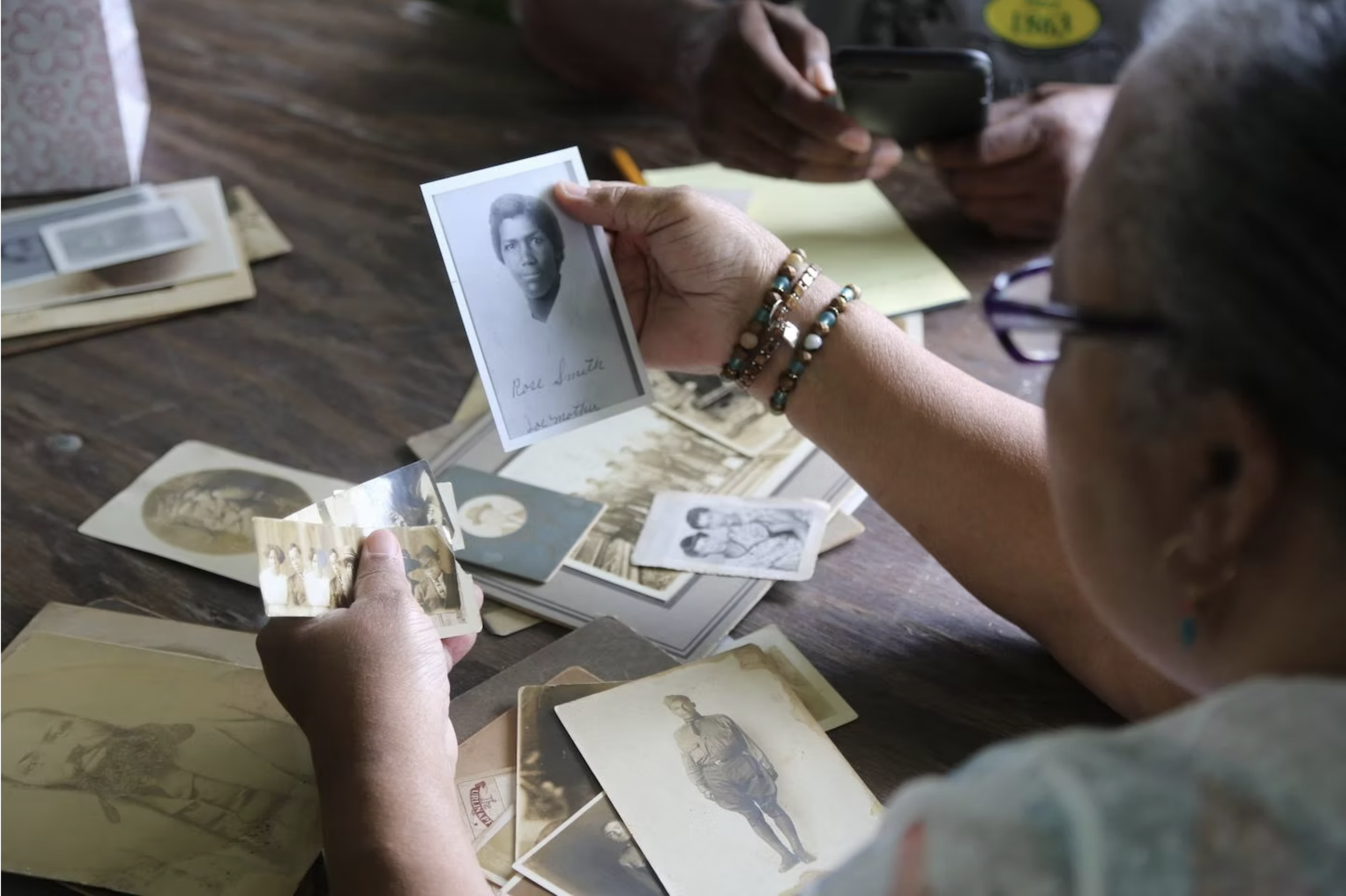One Place, Many Stories: Challenging the Myth of “White Appalachia”
Appalachia is not a monolith.
It’s a sentiment shared time and time again, from news organizations centered on the Black experience in West Virginia to works of fiction based in the reality of growing up Indigenous in North Carolina. Over 20% of the Appalachian population is nonwhite - including Black, Hispanic, and Indigenous folks, as well as many other races and ethnicities - and the region has become increasingly diverse since 2010. And yet, mainstream representations of the region almost always look the same: white.
The whitewashing of Appalachia is such a prevalent trope that it encompasses all the other stereotypes I’ve featured in this series. Despite the region’s increasing diversity, the connection between Appalachianness and whiteness remains so strong that Appalachian author Elizabeth Catte wrote in a 2018 op-ed that her most recent Google search for “Appalachian photography” pulled up “three times more images of white people in coffins than living people of color.”
Image courtesy of Black in Appalachia.
What’s interesting about these representations, though, is that Appalachian whiteness is often positioned as something separate from a general or “normal” whiteness - again, something “other.” Meredith McCarroll writes that Appalachians are often portrayed using many of the same tropes used to represent people of color, marking Appalachians as “phenotypically white [yet] hierarchically nonwhite” in a categorization she terms “unwhite.” In doing so, these representations inflict double damage by upholding and privileging some sort of “true” whiteness while simultaneously erasing the existence and contributions of people of color to the region’s history and culture.
In most popular media portrayals of Appalachia, whiteness is something seen and not heard; these representations simply systematically portray white people when Appalachia is concerned. However, some media about Appalachia does get explicit about race – and about Appalachian whiteness as something distinct from general whiteness. And it’s important to understand what’s being said.
White Appalachia: “Phenotypical Whiteness” and POC Erasure
The distinction of Appalachian whiteness as something different from “normal” whiteness can be traced back to a time before Appalachia was even recognized as a cultural or geographic region. An 1847 article on the South Carolina backwoods titled “The Carolina Sand-Hillers,” for example, describes the rural folk as “peculiar in dress and looks…as distinct a race as the Indian.” Later writers distinguished Appalachians as neither “white” nor “nonwhite” but what Anthony Harkins describes as a distinct “‘Cracker’ race” in all ways so debased that they had no capacity for social advancement.”
Following the establishment of Appalachia as a region, popular media too began to make explicit the whiteness of Appalachians. The popular comic strips Barney Google and Snuffy Smith and Li’l Abner of the mid-1900s also focus on their characters’ whiteness, albeit in different ways. DeBeck’s Snuffy Smith emphasizes the in-between social hierarchical space that his Appalachian characters occupy by demonstrating their position below “normal” white characters but above Black characters. Harkins explains this positioning further:
Whereas numerous characters in positions of status and authority (businessmen, bankers, judges, lawyers) commonly refer to Snuffy and his kin as “hill-billies,” “yokey(s),” and, even on one occasion, “back-woods trash,” black characters almost never call him anything other than “suh” or “boss.” […] In panels such as this, DeBeck asserts unequivocally Snuffy's whiteness through his domination over African-American figures, a quality that is meant to mitigate the degrading aspects of his character and to reinforce his role as mythic hero.
Capp’s Li’l Abner, on the other hand, emphasizes Appalachian whiteness by excluding Black characters from the comic completely. This omission can be attributed in part to a mandate of all newspaper syndicates of the era to avoid potentially controversial topics and a deep-seated (but incorrect) belief that the Southern mountains were a place untouched by slavery and racial tensions. But Capp’s exclusion of Black characters also says something about what his Appalachian characters are meant to signify, as Harkins continues:
[T]he mountaineers in this strip took the place of their black counterparts in other comic strips and throughout Depression-era popular culture; they are the clownish buffoons, the country innocents in the big city, the servants of socially superior white employers, or, in the case of the murderous Scraggs, the violent savages who threaten social order.
A panel from a 1938 edition of Al Capp’s Li’l Abner comic. Image courtesy of Brecht Bug on Flickr.
Ultimately, these images reveal a deeper assumption: Although whiteness is essential to Appalachianness, they are a different, “other” white.
News accounts of the Appalachian diaspora in the 1950s similarly emphasized the mountain migrants’ whiteness. As Harkins explains, in addition to a focus on Appalachians’ backwardness and potential criminality, these reports described a people who “despite their ‘superior’ racial heritage threatened the comity of the industrial heartland.” James Maxwell’s 1956 article “Down from the Hills and into the Slums” describes Appalachian migrants in overtly racial terms. Harkins summarizes the article’s opening lines:
After opening with a quote from an Indianapolis resident fearful of an uncivilized and dangerously independent population, Maxwell then informs his presumably shocked readers that this group was not Puerto Ricans or Mexicans but “white Anglo-Saxon Protestants,” a group “usually considered to be the most favored in American society.”
The 1958 Harper’s article “The Hillbillies Invade Chicago” contains similarly racialized language, opening with the claim that “The cities' toughest integration problem has nothing to do with Negroes” but rather “involves a small army of white Protestant, Early American migrants from the South.” This reference to integration, especially, indicates an underlying distinction between Appalachian whites and a more general whiteness.
Appalachian whiteness was used to further other political and social agendas, as well. The whiteness of Appalachian people was often a central focus of War on Poverty media, always containing the implicit argument that Appalachian poverty was an urgent matter because white people should not be poor. Michael Harrington’s influential novel The Other America put the whiteness of both Appalachian residents and migrants front and center, presenting the region as “the locus of white poverty in America, equivalent to the Black poor of the nation’s inner cities.” Much War on Poverty-era media similarly focused on white poverty, “offering proof that poverty was a problem facing the entire nation and not just inner-city minorities” and thus should be swiftly eradicated. In this way, the distinction of Appalachian people as white meant that their disadvantaged position needed to be corrected, though their poverty nonetheless marked them as something inherently different from middle-class white Americans. More modern media on Appalachian poverty, like ABC’s A Hidden America: Children of the Mountains, contains similar implicit arguments, though it focuses less explicitly on whiteness.
One note before closing: By highlighting this trend in national and popular media, which effectively erases the existence of people of color in Appalachia, I don’t mean to contribute to this erasure myself by ignoring the essential work being done by scholars, activists, and artists of color in Appalachia. Scholar Phillip J. Obermiller says it best in a review for the Journal of Appalachian Studies:
Charges of a “whitewashed” Appalachia ignore the works of Fayetta Allen, Edward J. Cabbell, Omope Carter Daboiku, Wilma Dunaway, Wilburn Hayden, Jr., bell hooks, Cicero M. Fain III, John C. Inscoe, Ronald L. Lewis, Joe William Trotter, William H. Turner, Thomas E. Wagner, Althea Webb, and this reviewer; the poetry of Effie Waller Smith, Frank X Walker, and Crystal Wilkinson; and the memoirs of Robert Armstead, Kojo (William T.) Jones, Jr., and Memphis Tennessee Garrison. Dissertations, book chapters, blog posts, and documentaries, along with newspaper, journal, and magazine articles add to this canon, rendering the trope of Black Appalachian invisibility to a form of vincible ignorance.
Media made by and featuring Appalachians of color certainly exists and deserves to be acknowledged. And while the existence and work of Appalachians of color are often recognized and celebrated by organizations, institutions, and individuals throughout the region, the unfortunate fact remains that popular representations of Appalachia – those which are most likely to be seen by an “outside” audience – tend to be overwhelmingly white.
Celebrating the Diversity of Life in Appalachia
Popular media tends to portray Appalachians as one singular demographic: white. In addition, they’re usually Christian in religion and often male in gender. And while that may be one way of life in the region, in reality, there are so many more. Here are some of my favorite stories from The Appalachian Retelling Project and beyond that highlight the diversity of life around Appalachia:
In South Williamson, KY, I spoke with Iman, who reflected on her upbringing as a Muslim in Eastern Kentucky.
In Knoxville, TN, I met with William Isom II and Dr. Enkeshi El-Amin of Black in Appalachia to discuss the work they’ve been doing to uncover the lost histories of Black Appalachians.
Krishna writes about how he navigates his own identity as an Appalachian with immigrant roots.
And in my first feature-length documentary, we explore the life and legacy of bell hooks, a feminist writer, thinker, and trailblazer who credited many of her philosophies to Kentucky’s “hillbilly culture.”
Appalachia is a complex place. Sometimes that makes it hard, but usually, it makes it beautiful. By understanding the vast number of ways people live in and experience the region, I hope we can work together to build a place that allows us all to thrive.
This blog post is part of an ongoing collaboration with the Civic Imagination Incubator, hosted by AccelerateKY in partnership with the University of Southern California Civic Imagination Project. In this series, members of the CI Incubator share their work combining worldbuilding, storytelling, and the civic imagination to develop impactful story worlds and media projects that engage participatory practices.




